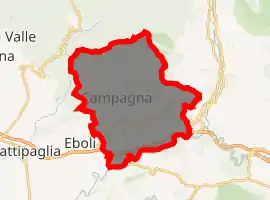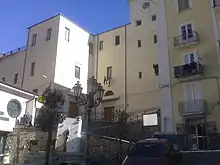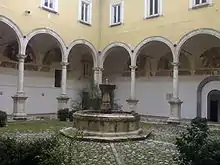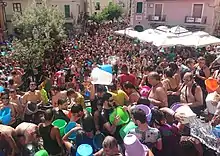Campagna
Campagna (Italian: pronounced [kamˈpaɲɲa]) is a small town and comune of the province of Salerno, in the Campania region of Southern Italy. Its population is 17,148.[3] Its old Latin name was Civitas Campaniae (City of Campagna). Campagna is located in one of the Picentini Mountains valleys at an altitude of 270 meters above sea level.
Campagna | |
|---|---|
.jpg.webp) General view of the town | |
-Stemma.png.webp) Coat of arms | |
 Campagna within the Province of Salerno | |
Location of Campagna 
| |
 Campagna Location of Campagna in Italy  Campagna Campagna (Campania) | |
| Coordinates: 40°40′N 15°6′E | |
| Country | Italy |
| Region | Campania |
| Province | Salerno (SA) |
| Frazioni | Camaldoli, Galdo, Mattinelle, Puglietta, Quadrivio, Romandola-Madonna del Ponte, Santa Maria La Nova, Serradarce. |
| Government | |
| • Mayor | Roberto Monaco |
| Area | |
| • Total | 135.41 km2 (52.28 sq mi) |
| Elevation | 270 m (890 ft) |
| Population (2009)[2] | |
| • Total | 16,183 |
| • Density | 120/km2 (310/sq mi) |
| Demonym(s) | Campagnesi |
| Time zone | UTC+1 (CET) |
| • Summer (DST) | UTC+2 (CEST) |
| Postal code | 84022 |
| Dialing code | 0828 |
| Patron saint | Antoninus of Sorrento |
| Saint day | 14 February |


History
The first records of the area date back to the IX century in the Lombard period. The position of the town was strategic for enemies attacks during the Middle Age. Lately, the town became an important cultural and religious center. It was home for many Bishops until the 1973 when the Diocese of Campagna merged with the Archdiocese of Salerno.
During the Second World War, Campagna was a temporary home for many Jews thanks to Giovanni Palatucci and his uncle Giuseppe Maria Palatucci. People arrived from the north of Italy and Campagna citizens hid those people in the basements of the churches. Giovanni was later honoured as a Righteous Among the Nations by the Yad Vashem Holocaust Memorial. Much of this is documented in Elizabeth Bettina's book, It Happened in Italy. Today, goods left by the Jews are shown in the Museo della Memoria in the Campagna town centre.
Geography
Campagna borders with Acerno, Contursi Terme, Eboli, Olevano sul Tusciano, Oliveto Citra, Postiglione, Serre and Senerchia (this one in the Province of Avellino),
The municipality counts the frazioni of Camaldoli, Galdo, Mattinelle, Puglietta, Quadrivio, Romandola-Madonna del Ponte, Santa Maria La Nova and Serradarce. Other localities are Avigliano, Folcata, Oppidi-Varano, Saginara and Sant'Angelo.
Tourist destinations
Castles, palaces, fountains and bridges
- Castle Gerione (10th century)
- Castle De Alegisio (10th century)
- Palazzo di Città (13th century)
- Palace Ducale Pironti (1694)
- Palazzo Tercasio (14th century)
- Palazzo dei Governatori dei Principi di Monaco (15th century)
- Palazzo Rivelli (14th century-17th century)
- Palazzo Pastore-Alinante (16th century)
- Palazzo Bernalla (14th century)
- Palazzo Trotta (16th century)
- Fountain Giudeca (15th century)
- Fountain S.Lucia (15th century)
- Fountain Cortiglia (15th century)
- Bridge of Presbyteres (15th century)
- Bridge of piazza Guerriero (15th century)
Churches, religious buildings and structures
- Basilica co-cathedral of Santa Maria della Pace (1112-1683)
- Church and convent Dominican of San Bartolomeo (14th century)
- Shrine of Madonna di Avigliano (1377)
- Church of SS. Annunziata (13th century)
- Church of SS Salvatore e Sant'Antonino (11th century)
- Church of S.Giovanni (16th century)
- Seminary di S. Spirito (15th century)
- Monastery of Maddalena (14th century)
- Church and convent of Osservanti della Concezione (15th century)
- Abbey of Santa Maria La Nova (1220–1249)
- Monastery of San Martino (16th century)
- Hermitage of S.Erasmo e S.Giacomo degli eremiti (11th century)
- Hermitage of San Michele di Montenero (12th century)
- Hermitage of S. Maria Domenica (16th century)
Museums
- Itinerario della Memoria e della Pace
- Museo della confraternita dei cinturati di Santa Maria del Soccorso
Nature reserve
- Oasi naturale del Monte Polveracchio
- Oasi di Persano
- Riserva naturale Foce Sele-Tanagro
Notable people
- Antoninus of Sorrento, catholic saint born at Campagna
- Honoré I, Lord of Monaco, Marquis of Campagna
- Charles II, Lord of Monaco, Marquis of Campagna
- Hercule, Lord of Monaco, Marquis of Campagna
- Honoré II, Prince of Monaco, Marquis of Campagna
- Juan Caramuel y Lobkowitz, bishop of Campagna
- Louis I, Prince of Monaco, Marquis of Campagna
- Giordano Bruno, philosopher Dominican friar
- Julius Caesar Capaccio, historian of Campagna
- Melchiorre Guerrriero, noble of Campagna
A' Chiena

Campagna is famous for its traditional summer event ‘A Chiena’ (Italian: La Piena), which takes place annually every weekend between July and August. During the event, the city river Tenza is deflected from its natural course through the city main street where people wait for the water to come.[4] This tradition comes from the ancient practice of cleaning the streets by using the river water. Later, it was converted into a delightful moment for locals and tourists.[5]
I Fucanoli
I Fucanoli is festival in honour of Sant'Antonio, taking place on the 17th of January. The celebrations begin in the late afternoon with a service followed by a procession whereby the Sant'Antonio statue is carried in the streets of the city centre. While the statue is carried through the streets, huge fires are ignited.
Sister city
Monte Carlo in the Principality of Monaco is Campagna's sister city.
References
- "Superficie di Comuni Province e Regioni italiane al 9 ottobre 2011". Istat. Retrieved 16 March 2019.
- "Popolazione Residente al 1° Gennaio 2018". Istat. Retrieved 16 March 2019.
- (in Italian) Source: Istat 2010
- ""A Chiena" water festival". Euronews. Retrieved 16 February 2018.
- "Continua a Campagna 'A Chiena': secchiate, balli e folklore con i piedi nell'acqua". Salernonotizie. 23 July 2017. Retrieved 16 February 2018.
External links
![]() Media related to Campagna at Wikimedia Commons
Media related to Campagna at Wikimedia Commons
- Official website (in Italian)
- Comuni italiani: Campagna (in Italian)